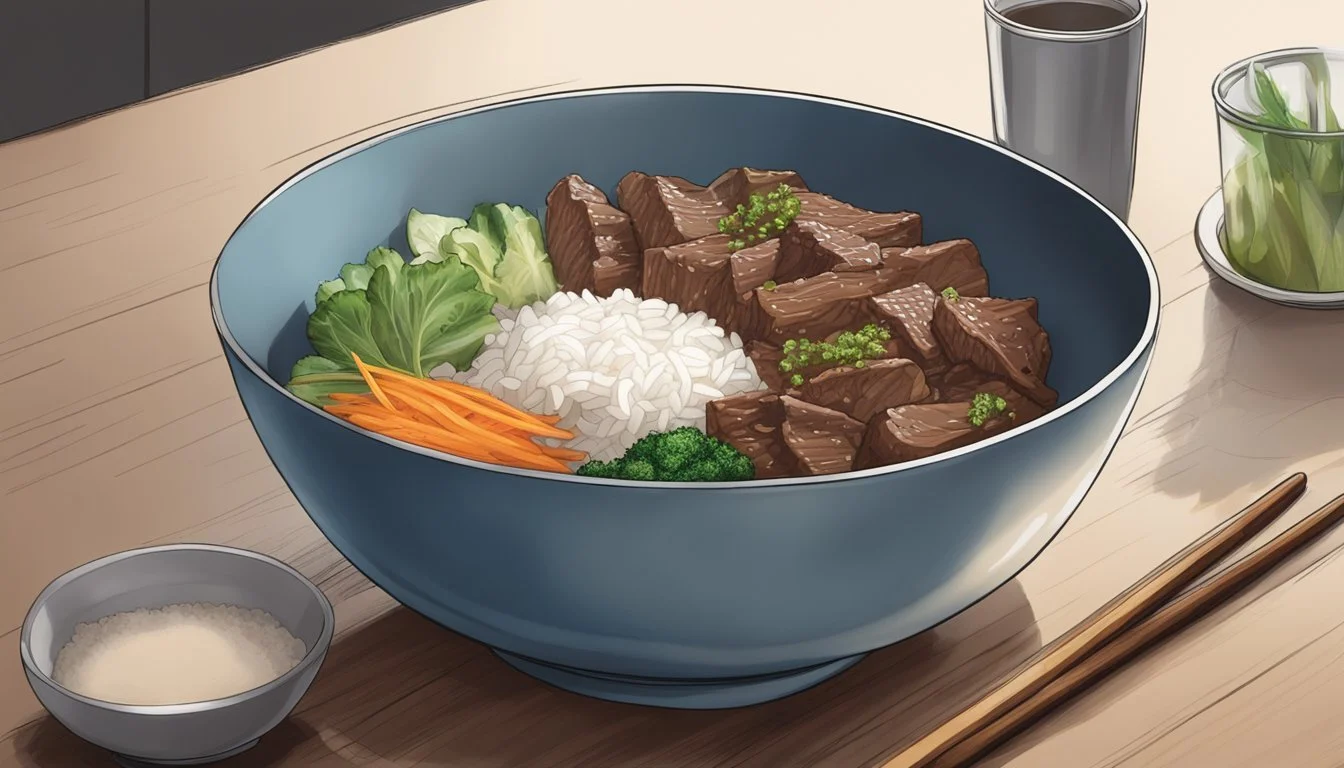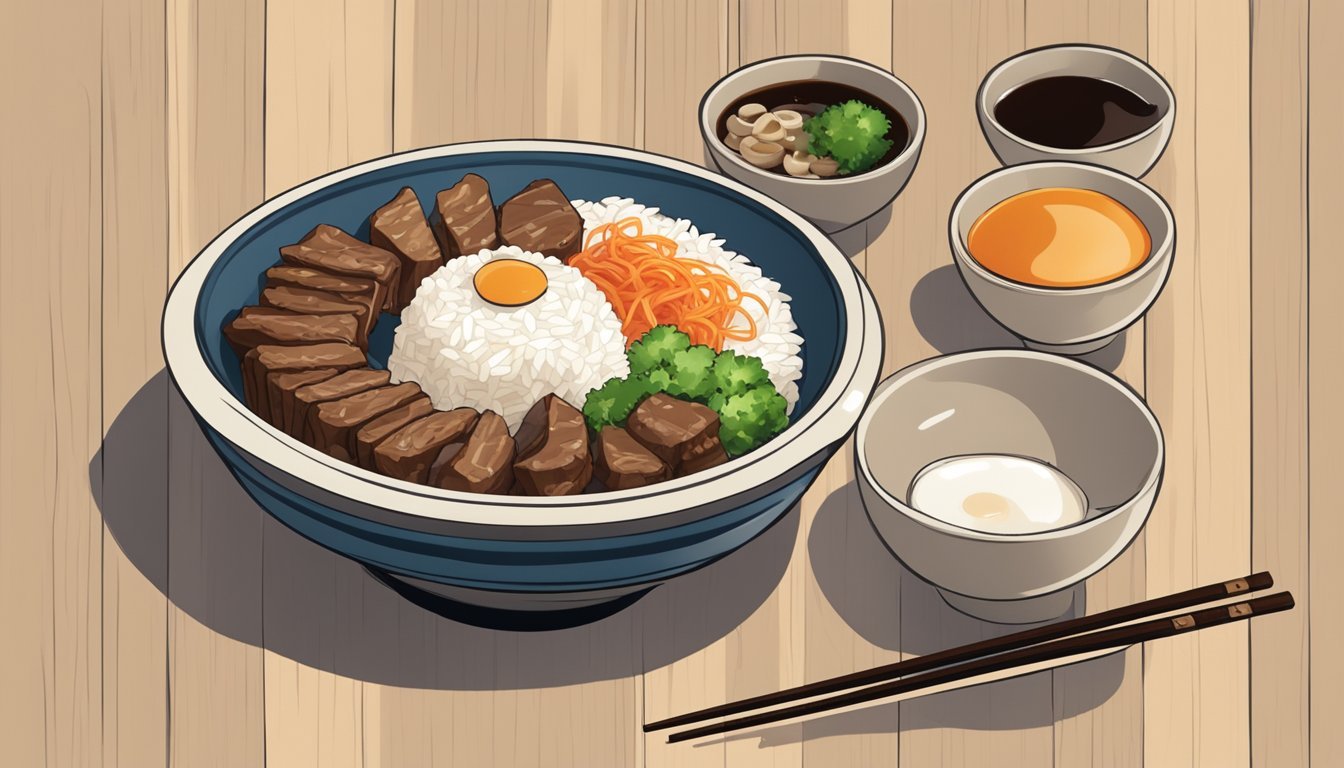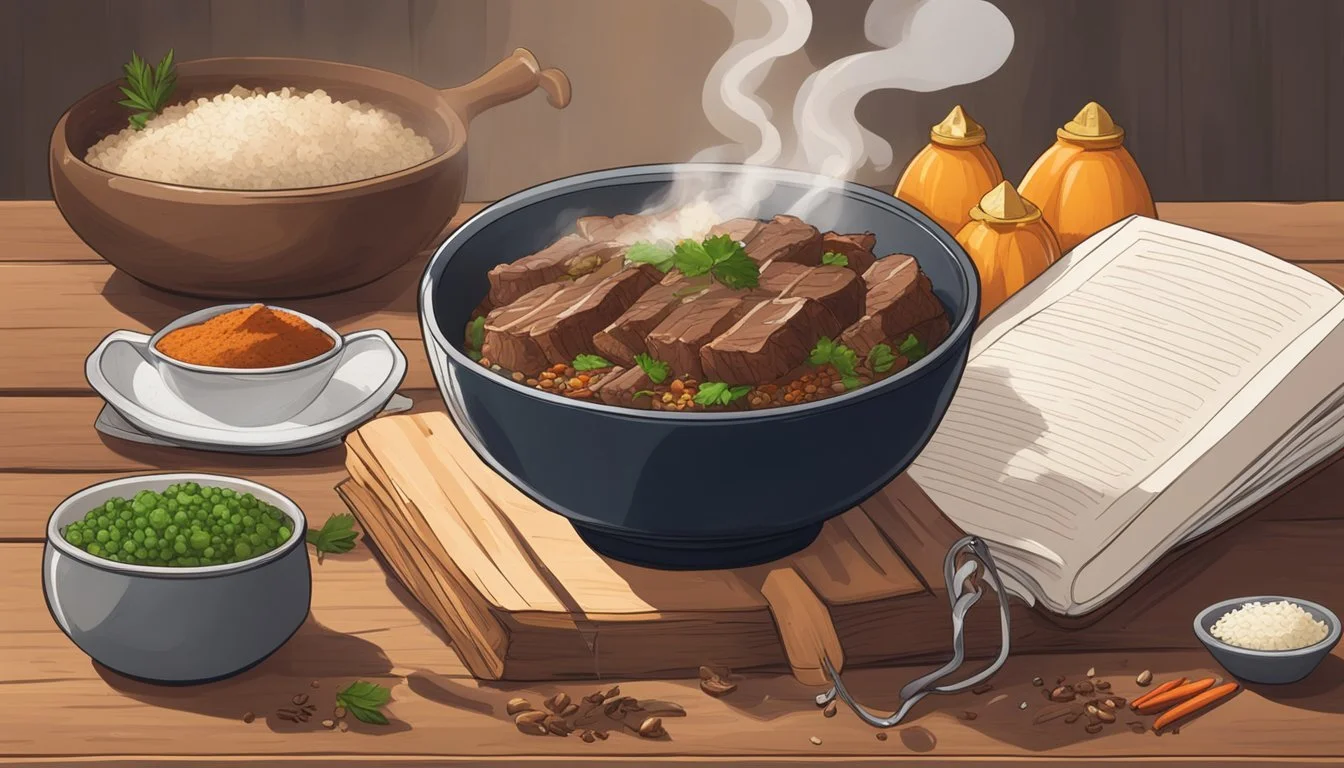How Long Do Beef and Rice Bowls Last?
Freshness Tips and Storage Guidelines
Knowing how long beef and rice bowls last is crucial for enjoying safe and delicious leftovers. Properly stored in the refrigerator, beef and rice bowls can last up to 4 days. This makes them an ideal meal prep option for busy weeks or a simple make-ahead dinner.
Storing beef and rice bowls in airtight containers helps maintain their flavor and texture. Additionally, freezing the bowls can extend their lifespan to about 2-3 months, providing flexibility for future meals. When it’s time to eat, ensure they are thoroughly reheated to enjoy the best taste and food safety.
Considering the convenience and longevity of beef and rice bowls, they are perfect for those looking to save time and reduce food waste. By following storage guidelines, one can savor these hearty and flavorful meals without compromise.
Understanding Beef and Rice Bowls
Beef and rice bowls are a popular dish featuring a combination of seasoned beef, rice, and various vegetables. These meals are not only flavorful but also provide a balanced nutritional profile. Below, the main components, nutritional aspects, and popular variations are discussed.
Components of a Beef and Rice Bowl
A typical beef and rice bowl starts with a base of steamed or stir-fried rice, often using white rice or brown rice for added fiber. The protein component usually includes ground beef or sliced beef, seasoned with ingredients like soy sauce, sesame oil, garlic, ginger, and a touch of sugar for balance.
Vegetables can include onions, green onions, carrots, and other seasonal veggies. Toppings might be sesame seeds, red pepper flakes, or a drizzle of additional sauce. The combination of flavors from sweet to savory makes this dish particularly appealing.
Nutritional Profile
Beef and rice bowls balance protein, carbohydrates, and fats, making them a nutritious choice. Ground beef, especially lean ground beef, provides essential amino acids and nutrients like iron and zinc. The rice contributes carbohydrates, which are a primary energy source.
Vegetables like carrots and green onions add vitamins, minerals, and dietary fiber. Using sesame oil and soy sauce in moderation enhances flavor without adding excessive calories. A standard serving might range between 400-600 calories, depending on portion sizes and specific ingredients used.
Popular Variations
There are several popular variations of beef and rice bowls. Korean Beef Rice Bowls, for instance, often feature Korean ground beef with a slightly sweet and spicy sauce made from soy sauce, brown sugar, and sriracha. Gyudon, a Japanese version, typically uses thinly sliced beef simmered in a savory broth with onions and served over rice.
Creative adaptations might include substituting white rice with quinoa for a nutrient boost, or adding avocado and lime wedges for a fresh twist. These variations showcase the versatility of the dish and its ability to cater to different palates and dietary needs.
Preparation and Cooking Techniques
Making a delicious beef and rice bowl involves careful preparation of each component. This ensures the dish has balanced flavors, textures, and presentation.
Cooking the Perfect Rice
For optimal results, white or brown rice can be used. To achieve fluffy rice, use a rice cooker or a pot with a lid. Rinse the rice in cold water until it runs clear. For white rice, use a ratio of 1:1.5 (rice to water), and for brown rice, use 1:2.
Bring the water and rice to a boil, then reduce the heat and simmer covered until the water is absorbed. Let the rice sit covered for 10 minutes before fluffing with a fork. This steaming step is essential for perfectly cooked rice.
Preparing the Beef
Choosing the right cut of beef is crucial. Ground beef, rib eye, or lean beef cut into thin slices are good options. Heat a large skillet or wok over medium-high heat with a tablespoon of sesame oil.
Add the thinly sliced beef to the skillet, allowing it to cook until it’s browned. Stir in minced garlic and ginger, cooking for an additional 1-2 minutes to enhance the umami flavor. If using a marinade, such as a teriyaki sauce, let the beef soak in it for at least an hour before cooking.
Combining Ingredients
After both the rice and beef are prepared, it’s time to combine them into a bowl. Begin with a base layer of steamed rice. Arrange the cooked beef over the rice, making sure it’s evenly distributed.
Toppings such as green onions, sesame seeds, and sautéed vegetables like carrots or bell peppers can be added for flavor and texture. Drizzle soy sauce or any preferred sauce over the bowl. Stir to combine just before eating to ensure each bite has a mix of ingredients.
Storage Guidelines
Proper storage is crucial to extend the shelf life and maintain the quality of beef and rice bowls. It involves attention to refrigeration, freezing, and reheating methods.
Refrigeration and Shelf Life
Beef and rice bowls should be stored in the refrigerator at 40°F (4.4°C) or below. Cooked rice lasts 4-6 days if stored properly in an airtight container.
For cooked ground beef or other meats in the bowl, consume within 3-5 days. Variety meats like liver or kidney, if included, should be eaten within 1-2 days.
To keep all ingredients fresh, always cool the bowls before refrigerating. Labeling containers with dates can help ensure portions are consumed within their optimal shelf life.
Freezing and Reheating
For longer storage, freeze beef and rice bowls within 2 hours of cooking. Ensure the freezer is set at 0°F (-18°C) or lower.
Cooked rice can maintain good quality for 1 month frozen. Cooked beef in rice bowls can last 2-3 months when frozen. Use airtight containers or vacuum-sealed bags to prevent freezer burn.
When reheating, thaw in the refrigerator overnight. Reheat thoroughly in the microwave or on the stove until steaming hot, ensuring even warming throughout the dish. Avoid partial thawing and refreezing, as this affects the texture and safety.
Serving Suggestions
Enhance the experience of beef and rice bowls by incorporating flavor-rich accompaniments and versatile sauce options. These details add depth, balance, and a unique touch to each serving.
Accompaniments
Various accompaniments can elevate the taste and texture of beef and rice bowls. Kimchi and pickled cabbage bring a tangy and spicy flavor, pairing well with the savory beef. Sliced cucumber offers a refreshing contrast, balancing the rich elements.
Adding green beans enhances the nutritional value and offers a subtle crunch. Fried or soft-boiled eggs introduce a savory depth that complements the dish's main flavors. Consider toasting sesame seeds to sprinkle on top for an added nutty aroma and texture.
Vegetables like steamed broccoli or stir-fried bell peppers can also be included for more variety. Serving the bowl with a side of miso soup or simple salads with rice wine vinaigrette can round off the meal perfectly.
Sauce Options
Sauce options can drastically change the bowl's flavor profile. A mixture of soy sauce, dark soy sauce, and toasted sesame oil provides a simple yet rich base. Sriracha can be drizzled for those who appreciate a spicy kick.
Alternately, a blend of sriracha mayo adds a creamy, spicy element that melds well with the sweetness of the beef. Mirin or rice wine can add a slight sweetness, balancing the dish when mixed with soy sauce.
Experimenting with garlic and ginger-infused soy sauces or a splash of fish sauce can introduce complexity. For a sweet-savory touch, a small amount of honey or brown sugar can be whisked into the soy sauce base.
These sauces not only add layers of flavor but also allow for personalization, making each beef and rice bowl uniquely satisfying.
Healthier Alternatives
Whether seeking to reduce calories or eliminate meat from your diet, there are numerous healthier alternatives for beef and rice bowls that ensure a nutritious and satisfying meal.
Low-Calorie Substitutes
For a lighter meal, consider using cauliflower rice instead of traditional white or brown rice. Cauliflower rice is low in calories and carbohydrates while providing extra fiber and vitamins.
Another option is zucchini noodles, which are versatile and add a fresh, crisp texture. Shirataki noodles, made from konjac yam, can also replace rice.
Switching out ground beef for ground chicken or ground pork can reduce fat content significantly. Incorporating vegetables such as bell peppers, asparagus, and cabbage not only adds bulk but also enhances nutrition and flavors.
Vegetarian Options
Vegetarian beef and rice bowls can be just as hearty and delicious. Use plant-based meat alternatives like those made from soy or pea protein to replicate the texture of ground beef.
Tofu or tempeh can be marinated and cooked to absorb rich flavors. For the base, opt for brown rice, which retains more fiber and nutrients compared to white rice.
Top the bowl with a variety of vegetables such as bell peppers, asparagus, and cabbage for added nutrients. For sweeteners, using a natural option like honey or agave can enhance flavor without adding too many empty calories.
Recipe Tips and Tricks
To enhance the flavor and speed up the preparation of beef and rice bowls, consider these practical tips. Using the right tools and ingredients can make a significant difference, resulting in a delicious meal with minimal effort.
Enhancing Flavor
Adding umami flavors can elevate your beef and rice bowls. Ingredients like soy sauce, minced ginger, and garlic are essential. Use a garlic press to finely mince garlic, ensuring even distribution and a more intense flavor.
Topping the dish with toasted sesame seeds and sliced green onion adds texture and a fresh, crisp element. For extra zing, consider incorporating pickled red ginger.
Marinating the beef for at least an hour in teriyaki or soy-based sauce can enhance the flavors deeply. When cooking, use a wok or large skillet on high heat to achieve a seared, caramelized exterior while keeping the inside juicy.
Quick Preparation Methods
For a quick and easy recipe, prep time and cook time are critical. Opt for an Instant Pot if you have one; it can significantly reduce the total time to about 20 minutes. Browning the beef and cooking the rice simultaneously can streamline the process.
Utilizing pre-prepared ingredients, such as pre-minced ginger or pre-chopped veggies, can cut down on prep time. Additionally, using a large skillet over medium-high heat can cook the beef in about 6-10 minutes.
Assembling the bowl is quick: rice first, then beef, and top with vegetables and garnishes. This method ensures each flavor is distinct yet complementing.
Meal Planning and Prep
Meal planning and preparation can significantly simplify daily cooking, especially for busy weeknights. Beef and rice bowls are excellent options for meal prep as they offer convenience, nutrition, and versatility.
Ideal for Meal Prep
Beef and rice bowls, such as a Korean ground beef recipe, are perfect for meal prep due to their hearty ingredients. Typical components—beef, rice, vegetables—retain their quality when stored correctly. Beef can last 3-4 days in the fridge, making it a reliable ingredient for a week's worth of meals. Cooked rice should be consumed within a similar timeframe to maintain texture and prevent spoilage. Including vegetables can enhance the nutritional balance and add variety to the dish.
Use airtight containers to store individual servings, ensuring the freshness of each meal. Microgreens or lightly cooked vegetables can be added for extra crunch and nutrients. It’s beneficial to let cooked ingredients cool completely before sealing them to prevent condensation, which can lead to sogginess and spoilage.
Scaling for Servings
One of the advantages of preparing beef and rice bowls is the ease of scaling the recipe up or down. Batch cooking allows for efficient use of time and ingredients. For instance, doubling a meal prep recipe can provide multiple servings for different days, reducing daily cooking time.
Estimate portions by considering the main components: typically, ½ to 1 cup of cooked rice and 3-4 ounces of ground beef per serving. Adjust quantities based on personal preferences or dietary needs. Keeping a variety of comfort food ingredients on hand ensures that each bowl remains satisfying and balanced, even when preparing large quantities.
When prepping for the week, label containers with the preparation date to keep track of freshness. Consider freezing portions if they won't be consumed within four days, extending the lifespan of your meals up to several weeks. Proper planning guarantees delicious and nutritious weeknight meals ready to enjoy.









